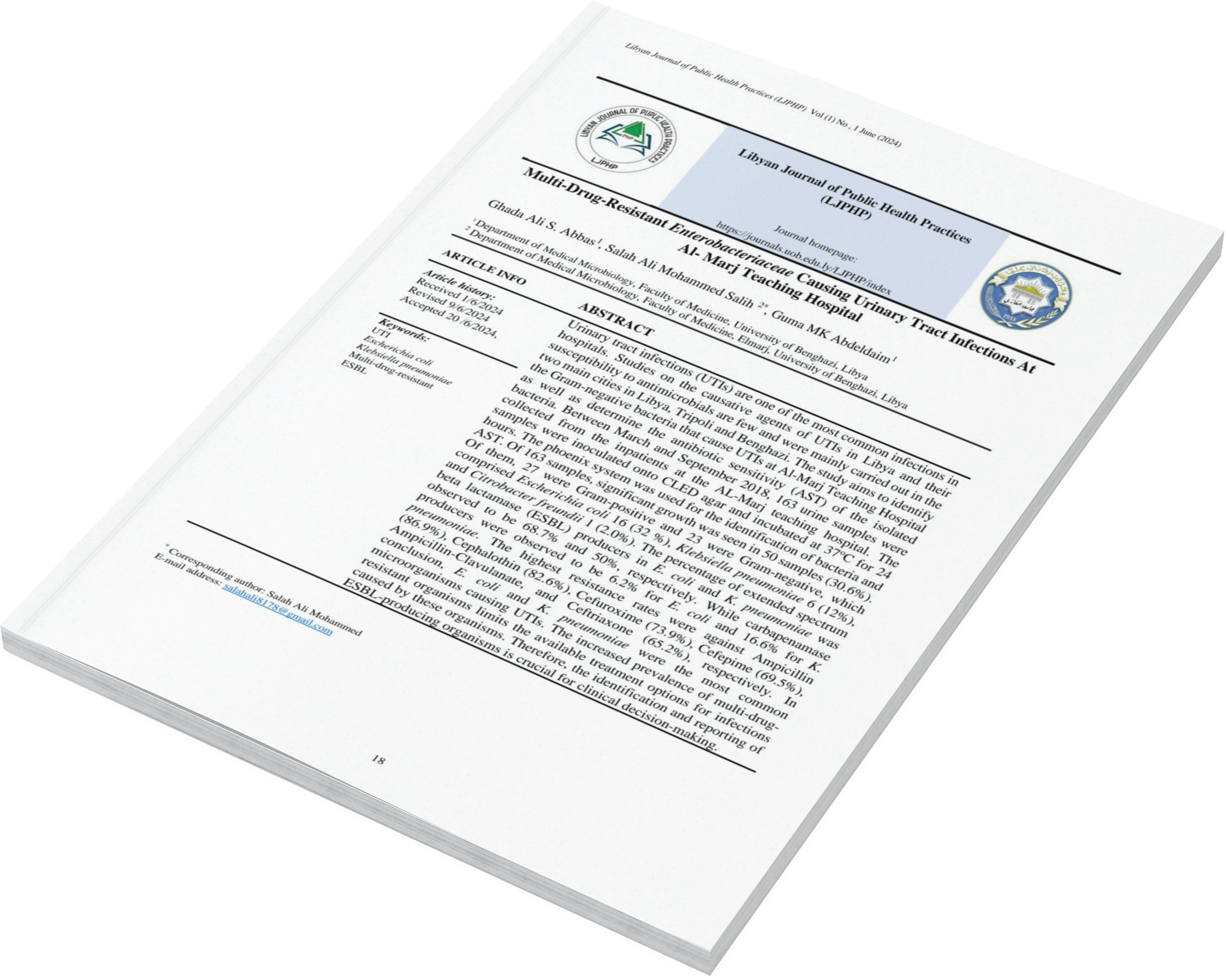Multi-Drug-Resistant Enterobacteriaceae Causing Urinary Tract Infections At Al- Marj Teaching Hospital
DOI:
https://doi.org/10.37376/ljphp.v1i1.6830Keywords:
ESBL, Multi-drug-resistant, Klebsiella pneumoniae, Escherichia coli, UTIAbstract
Urinary tract infections (UTIs) are one of the most common infections in hospitals. Studies on the causative agents of UTIs in Libya and their susceptibility to antimicrobials are few and were mainly carried out in the two main cities in Libya, Tripoli and Benghazi. The study aims to identify the Gram-negative bacteria that cause UTIs at Al-Marj Teaching Hospital as well as determine the antibiotic sensitivity (AST) of the isolated bacteria. Between March and September 2018, 163 urine samples were collected from the inpatients at the AL-Marj teaching hospital. The samples were inoculated onto CLED agar and incubated at 37oC for 24 hours. The phoenix system was used for the identification of bacteria and AST. Of 163 samples, significant growth was seen in 50 samples (30.6%). Of them, 27 were Gram-positive and 23 were Gram-negative, which comprised Escherichia coli 16 (32 %), Klebsiella pneumoniae 6 (12%), and Citrobacter freundii 1 (2.0%). The percentage of extended spectrum beta lactamase (ESBL) producers in E. coli and K. pneumoniae was observed to be 68.7% and 50%, respectively. While carbapenamase producers were observed to be 6.2% for E. coli and 16.6% for K. pneumoniae. The highest resistance rates were against Ampicillin (86.9%), Cephalothin (82.6%), Cefuroxime (73.9%), Cefepime (69.5%), Ampicillin-Clavulanate, and Ceftriaxone (65.2%), respectively. In conclusion, E. coli and K. pneumoniae were the most common microorganisms causing UTIs. The increased prevalence of multi-drug-resistant organisms limits the available treatment options for infections caused by these organisms. Therefore, the identification and reporting of ESBL-producing organisms is crucial for clinical decision-making.
References
Sekmenli T, Kara F. Association of vesicoureteral reflux and renal scarring in urinary tract infections. Pediatr Int. 2018;116(4):542-547.
Ashur AB, El Magrahi H, Elkammoshi A, Alsharif H. Prevalence and antibiotics susceptibility pattern of urine bacterial isolates from Tripoli Medical Center (TMC), Tripoli, Libya. Iberoam J Med. 2021;3(3):221-226.
Salem MA, et al. Bacterial Profile of Urinary Tract Infection and Antimicrobial Susceptibility Pattern Among Patients Attending at Bushra. J Microbiol Infect Dis. 2018;7(4):2671-2675. doi: 10.17554/j.issn.2224-3992.2018.07.788
Feld LG. Urinary Tract Infections and Vesicoureteral Reflux in Infants and Children. Pediatr Infect Dis J. 2013;31(11):451. doi: 10.1542/pir.31-11-451
Birnie K, et al. Comparison of microbiological diagnosis of urinary tract infection in young children by routine health service laboratories and a research laboratory: Diagnostic cohort study. PLoS One. 2017;12(2):e0171113.
Bagchi I, Jaitly NK, Thombare VR. Microbiological evaluation of catheter-associated urinary tract infection in a tertiary care hospital. People J Sci Res. 2015;8:23-9.
Baloch BK, et al. Antibiotic Antibiogram in Patients with Complicated Urinary Tract Infections in Nephrology Unit of South Waziristan. Cureus. 2022;14(10).
O’Grady MC, et al. Empirical treatment of urinary tract infections: how rational are our guidelines? J Antimicrob Chemother. 2019;74(1):214-217.
Prais D. Bacterial susceptibility to oral antibiotics in community-acquired urinary tract infection. Arch Dis Child. 2003;88(3):215-218.
Pezzlo M. Laboratory diagnosis of urinary tract infections: guidelines, challenges, and innovations. Clin Microbiol Newsl. 2014;36(12):87-93.
Hilt EE, et al. Urine is not sterile: use of enhanced urine culture techniques to detect resident bacterial flora in the adult female bladder. J Clin Microbiol. 2014;52(3):871-876. doi: 10.1128/JCM.02876-13
Hara CMO. Evaluation of the Phoenix 100 ID/AST System and NID Panel for Identification of Enterobacteriaceae, Vibrionaceae, and Commonly Isolated Nonenteric Gram-Negative Bacilli. J Clin Microbiol. 2006;44(3):928-933. doi: 10.1128/JCM.44.3.928
Carroll KC, et al. Evaluation of the BD Phoenix automated microbiology system for identification and antimicrobial susceptibility testing of staphylococci and enterococci. J Clin Microbiol. 2006;44(6):2072-2077.
Khawcharoenporn T, Vasoo S, Singh K. Urinary tract infections due to multidrug-resistant Enterobacteriaceae: prevalence and risk factors in a Chicago emergency department. Emerg Med Int. 2013;2013:258517.
Mazzariol A, Bazaj A, Cornaglia G. Multi-drug-resistant Gram-negative bacteria causing urinary tract infections: a review. J Chemother. 2017;29(sup1):2-9.
Abujnah AA, et al. Multidrug resistance and extended-spectrum β-lactamases genes among Escherichia coli from patients with urinary tract infections in Northwestern Libya. Libyan J Med. 2015;10(1).
Mohammed MA, et al. Prevalence and antimicrobial resistance pattern of bacterial strains isolated from patients with urinary tract infection in Messalata Central Hospital, Libya. Asian Pac J Trop Med. 2016;9(8):771-776.
Vachvanichsanong P, McNeil EB, Dissaneewate P. Extended-spectrum beta-lactamase Escherichia coli and Klebsiella pneumoniae
urinary tract infections. Epidemiol Infect. 2021;149:e12.
Llor, C., Bjerrum, L., & Strandberg, E. L. Microbiology of urinary tract infections in primary care patients: a cross-sectional study in the community in Spain and Sweden. BMC Family Practice. 2020; 21(1), 1-9.
Gales, A. C., Seifert, H., Gur, D., Castanheira, M., & Jones, R. N. Antimicrobial susceptibility of Gram-negative bacteria isolated from patients hospitalized in intensive care units in United States and European hospitals. 2019; 2009–2011). Diagnostic Microbiology and Infectious Disease, 73(4), 328-334.
Kuti, J. L., Patel, A. A., Coleman, C. I., & Nicolau, D. P. Antimicrobial activity of daptomycin against gram-negative pathogens: Results from SURVEILLANCE studies. Pharmacotherapy: The Journal of Human Pharmacology and Drug Therapy. 2020; 40 (9), 839-847.
Magiorakos, A. P., Srinivasan, A., Carey, R. B., Carmeli, Y., Falagas, M. E., Giske, C. G., & Monnet, D. L. Multidrug-resistant, extensively drug-resistant and pandrug-resistant bacteria: an international expert proposal for interim standard definitions for acquired resistance. Clinical Microbiology and Infection. 2012;18 (3), 268-281.
Pitout, J. D., Nordmann, P., & Poirel, L. Carbapenemase-producing Klebsiella pneumoniae, a key pathogen set for global nosocomial dominance. Antimicrobial Agents and Chemotherapy. 2018; 62(1), e01019-17.
Paterson, D. L., & Bonomo, R. A. Extended-spectrum β-lactamases: a clinical update. Clinical Microbiology Reviews. 2018; 18(4), 657-686.
World Health Organization. (2019). Antimicrobial resistance: Global report on surveillance. WHO

Downloads
Published
How to Cite
Issue
Section
License

This work is licensed under a Creative Commons Attribution-NonCommercial-NoDerivatives 4.0 International License.











